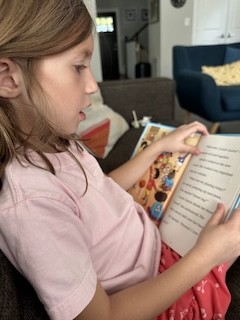Teacher question:
When measuring oral reading fluency by, say, having kids read a grade-level text for one minute, I take note of speed and accuracy.
1. Should I also measure expression? I certainly know expression is part of fluent reading, but isn’t a kid trying to read fast and accurate not really able to read with perfect expression? For example, they might take nice pauses and commas and question marks but slow down their words per minute score.
2. Should I also measure retell? Keep in mind my concerns in my first question. Plus, fluency and comprehension seem like they would be difficult to measure simultaneously on just a one-minute passage. Why? a kid could just give me a lot of fluff in his retell, and a kid with a lower WPM score wouldn’t have read many details to retell.
Shanahan responds:
From the beginning, educators have emphasized accuracy and speed when evaluating oral reading (Starch, 1915). The prosody or expression of this tested reading may be weighed, but only subjectively as an additional quality factor.
Over the years, o the relative prominence of accuracy (e.g., Betts, 1940) and speed (Good & Kaminski, 1996) in oral reading ratings has varied, but expression has always been the red-haired stepchild.
You are absolutely correct: if kids are putting a premium on speed, then careful attention to expression will only slow them down. And yet, there is no reason for you to focus on speed alone. As a teacher, your interest should be in their oral reading fluency, which is a different thing altogether.
If my Uber-driver estimates time to destination (10 miles away) at 5 minutes, he might be telling the truth. His car really may go 120 miles per hour. But his estimate is of no use to me, since I’m not only want to arrive soon, but safely, too.
Fluency matters because of its relationship to reading comprehension, and its predictive and determining power are quashed when you ignore any of its essential parts (Valencia, et al., 2010). This is especially true when this disregard encourages kids to read in a peculiar fashion.
We simply don’t care how fast kids can say the words, we want to know how fluently they can translate print to meaningful oral language.
In a word, yes, indeed, it is a good idea to measure oral reading expression or prosody!
A rich body of research evidence for this is accumulating (Daane, et al., 2005; Miller & Schwanenflugel, 2008; Paige, et al., 2014; Pinnell, et al., 1995; Rasinski, et al., 2009; Valencia, et al., 2010; Veenendial, et al., 2019; Whalley & Hansen, 2006).
So how to best measure expression?
First, 1-minute reads aren’t best. Research shows that 3-minute reads do a markedly better job in predicting comprehension scores (Valencia, et al., 2010). Even tests like DIBELS accomplish their high reliabilities by combining the results of multiple 1-minute reads.
Second, tell students that they’ll be questioned after the oral reading. You want to evaluate fluency in a comprehension-oriented milieu not a speed-oriented one. (I like basketball players who are quick to the hoop, but this needs to be controlled speed—speed checked by the need to score and not to foul).
Third, definitely keep track of student accuracy (marking errors) and reading rate (words correct per minute).
But also, evaluate expression. There are many ways to do this. In my schools I encouraged use of the NAEP rubric developed by Gay Su Pinnell and her colleagues (Pinnell, et al., 1995):
1 – Student reads word-by-word. Occasional 2-word or 3-word phrases may occur—but infrequently and they don’t preserve meaningful syntax.
2 - Reads primarily in 2-word phrases with some 3- or 4-word groupings. Some word-by-word reading. Word groupings unrelated to context of sentence or passage.
3 - Primarily in 3- or 4-word phrases (with some smaller groupings, too). Majority of phrasing seems meaning appropriate and preserves syntax of the text. Little or no expressive interpretation.
4 - Reads primarily in larger, meaningful phrases. Although some regressions, repetitions, and deviations from text may occur, these don’t detract from the meaning or language of the text. Some expressive interpretation.
The hardest distinction here tends to be between the 2 and 3 ratings. The key to making that decision accurately is to focus less on the numbers of words between pauses and more on how meaningful or syntactically correct the groupings are.
For instance, look at these pause patterns:
“Tell me /about it,”/ said Lucas, shaking his /head /sadly./
“Tell me about it,”/ said Lucas, /shaking his head sadly./
The first I’d rate a 2, and the second a 3. The first rendition doesn’t consistently rely on the text’s punctuation, and the pauses don’t reflect an attempt to preserve meaning as much as, a need for extra time to figure out one word or another.
The second version does a better job of conveying the author’s meaning and punctuation. If you didn’t have that text before you, you’d easily grasp its meaning from the oral presentation alone. (If it hadn’t been read so monotonously—which is not marked here, it would have been a 4).
There is a more recent scheme (Benjamin, et al., 2013), the Comprehension and Oral Reading Fluency Scale (CORFS), that I like, too, but I haven’t used that one myself. It, too, is a 4-point rubric focusing on the appropriateness and lengths of pauses and their relationship to meaning and syntax.
Research shows that these rubrics are reasonably easy to use, reliable, closely related to reading comprehension, reflective of objective measures of prosody (such as spectrographic analyses), and that they add useful information beyond accuracy and speed (Benjamin, 2013; Pinnell, et al., 1996; Smith & Paige, 2019; Wang, et al., 2019).
Like you, I don’t invest a great deal of faith in those oral reading retellings or responses to questions. And by Grade 2, I’m more interested in the kids’ silent reading comprehension anyway.
Nevertheless, always tell students that you will follow up their oral reading assessments with a question of some kind or a retelling—even if you don’t intend to use that information for assessment purposes.
Kids read differently if they are trying to understand a text than if they are just putting on an oral reading show. You want to know how accurately, how appropriate the rate, and how meaningful the expression the oral reading is—in a context in which kids are trying to understand text. (I will depend on retellings of silent readings at most grade levels to evaluate that aspect of their reading.)







Comments
See what others have to say about this topic.